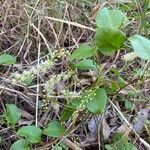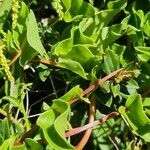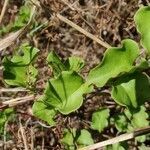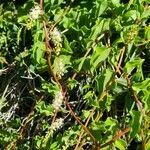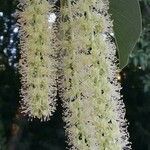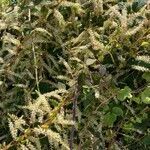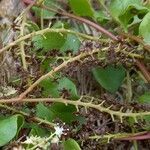Annual shoots up to 6 m; rhizome thick and hardy. Leaves short-petioled, ovate, subcordate, acute or blunt, thin-fleshy, 1-11 by ¾-8 cm, producing small axillary tubercles (BAILEY). Racemes simple or split into 2-4 branches with a thin, rich-flowered rhachis, incl. the peduncle 4-30 cm. Bracts narrow, at most as long as the pedicels, persistent. Pedicels 1.5-2 mm, re-ceptacular tip cup-shaped by 2 persistent, broad-triangular, acute, hyaline lower bracteoles. Upper pair of bracteoles greenish-white, shorter than the perianth, convex in bud, later flattening, broad-elliptic to suborbicular, c. 1.25-2 by 1-1.5 mm. Perianth fragrant, white, nigrescent, patent in anthesis, c. 3.5-6 mm diam., segments ovate-oblong to elliptic, blunt, 1 1/3-3 by 1-2 mm, hardly longer than the stamens and pistil. Stamens white, filaments in bud sharply reflexed at the apex, in anthesis spreading. Style white, but split to various degree into 3 stigmatic arms, each with 1 (rarely 2) club-shaped or broad-elliptic stigmas. Fruit unknown.
Twining vine, with root-crown tuber, and often developing aerial tubers from leaf axils. Aerial stems usually less than 10 m long but recorded to 40 m. Leaves alternate; lamina ovate or broadly ovate to cordate, 2–15 cm long, 1–12 cm wide, cordate at base, entire, acute to obtuse or sometimes shortly acuminate or emarginate at apex, ± fleshy to succulent, glossy above, glabrous; petiole 0.5–2 cm long. Racemes pendulous, 6–25 (–30) cm long; flowers numerous, sweet-scented. Pedicels 3–4 mm long; bracts subulate to narrowly ovate, 1.5–2.5 mm long. Tepals ovate or ovate-oblong to elliptic, obtuse, c. 2–3 mm long, spreading, white to cream. Stamens 2–2.5 mm long, ascending, strongly divergent; filaments c. 1 mm wide at base, tapering to anther. Style shallowly or deeply trifid; stigmas ± clavate. Fruit an indehiscent, subglobular capsule. Seed 1, globular, smooth (fruit and seed-set uncommon in Australia).
Vines twining, with thick, hardy rhizome. Leaves shortly petiolate; leaf blade ovate to subcordate, 2-6 × 0.5-5.5 cm, thinly fleshy, base rounded or cordate, apex acute, producing small axillary tubercles (bulbils). Racemes many flowered; rachis pendent, thin, 7-25 cm. Bracts not longer than pedicel, narrow, persistent. Pedicel 2-3 mm, receptacular tip cupular, flowers shed from here. Lower bracteoles broadly triangular, hyaline, apex acute, persistent; upper bracteoles greenish white, flattened, orbicular to broadly elliptic, shorter than perianth. Flowers ca. 5 mm in diam., fragrant. Perianth white, inflexed, patent in anthesis; segments ovate or oblong to elliptic, 3 × 2 mm, apex blunt. Stamens white; filaments reflexed at apex in bud, spreading in anthesis. Style white, split to 3 stigmatic arms, each with 1 club-shaped or broadly elliptic stigma. Utricle and seed not seen. Fl. Jun-Oct.
Stems climbing, slender and often reddish. Lvs subsessile or with petiole to 1-(2) cm long, commonly with small irregular tubers in their axils. Lamina 2-11-(13) × 1.75-10-(11) cm, broadly ovate, often involute, scarcely succulent to succulent according to degree of exposure, shining; base subcordate or cordate; apex obtuse. Racemes simple or 2-4-branched, pendent, to c. 18 cm long excluding common peduncle, with numerous small, white, fragrant fls. Pedicels 2-3 mm long; bracts 1.5-1.8 mm long, lanceolate-subulate. Lower bracteoles 0.5-1 mm long, cupulate; upper bracteoles c. 2-2.5 mm long, suborbicular. Tepals 2-3 mm long, elliptic-oblong to broadly elliptic. Filaments narrow-triangular, widely divergent, bending outwards near base. Style 1, < stamens; branches 1/2-3/4 length of fused part; stigmas clavate.
A climber or vine. The stems are 3-7 m long. It has aerial potato like tubers along the stem. They are 1-3 cm long. The leaves are small, fleshy and closely arranged. They are simple and 3-15 cm long by 2-10 cm wide. The leaf stalks are 5-15 cm long. The flowers are small, white and fragrant. The are in racemes in the axils of leaves. The flowers are about 6 mm across. They are white with green or white bracts. They have a scent. The fruit is a nut about 1 mm across.
Perennial climber, succulent, 1.5-8.0 m high; much branched, stems semi-succulent, drapes itself over other plants. Leaves semi-succulent, bright glossy green. Inflorescences spikes, ± 300 mm long. Flowers ± 5 mm in diam., white, showy, fragrant. Stigma 3-cleft, style division varies. Fruit none, reproducing from aerial tubers; tubers produced in leaf axils which later drop to the ground.


